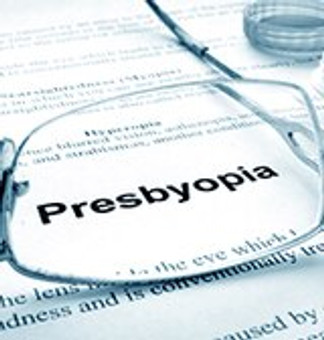Presbyopia is a gradual loss of the eye's ability to focus on nearby objects in people over the age of 40. It is an unavoidable, age-related condition that can interfere in everyday tasks like reading, working on computer, or using your phone. Even if you never had a vision problem before, presbyopia is inevitable. This condition is also a significant and emotional event because it's a sign that you’re aging, which is something that's impossible to ignore or hide. Even nearsighted people will notice that their near vision blurs when they wear their usual eyeglasses or contact lenses to correct distance vision.
The good news is that presbyopia can be easily diagnosed and there are a number of treatment options available to help restore near vision.
What Causes Presbyopia?
Normally the eye’s lens is soft and flexible, readily changing shape to see images from different distances. As you age, the lens in your eye hardens and loses elasticity. With this loss of flexibility, your eyes are less able to adjust properly to focus on near objects.
While considered an age-related eye condition, there are additional recognized risk factors that can cause early development, or faster development, in some people, including: being female, having diabetes, Multiple Sclerosis, cardiovascular disease, anemia, hyperopia, eye trauma or injury, myasthenia gravis (a neuromuscular disorder), vascular insufficiency, eating a poor diet, diagnosis of decompression sickness from scuba diving, and excessive alcohol consumption. Taking certain prescription drugs such as antianxiety drugs, antipsychotics, antispasmodics, antidepressants, antihistamines and diuretics can also increase or expedite development.
Symptoms And Signs Of Presbyopia
You will notice that you are holding your reading material further from your eyes in order to see it more clearly. However, when you move things farther from your eyes they get smaller in size, so this is only a temporary and partially successful solution to presbyopia. Presbyopia can also cause headaches, eye strain, and visual fatigue that makes reading and other near vision tasks less comfortable and more tiring.
7 Treatments For Presbyopia

As mentioned above, presbyopia can be easily diagnosed and also there are several options to treat presbyopia – your eye practitioner can help you choose the best option for you.
1. Eyeglasses
The simplest and most common treatment for presbyopia is with bifocal or progressive lens eyeglasses. A bifocal lens is split into two sections - the larger, primary section corrects for distance vision, while the smaller, secondary section allows you to see up close. But these lenses aren’t as popular these days because they provide a more limited range of vision for many people with presbyopia. Also, most people don't want to show their age by wearing eyeglasses that have a visible bifocal line.
Progressive lenses function in a similar way, except that the sections of the lens optimized for distance and near vision are more blended (as opposed to the two distinct zones that characterize bifocals). These line-free multifocal lenses provide excellent vision at all distances, as well as restore clear near vision. And for people who notice that they are becoming more sensitive to light and glare due to aging changes in their eyes, photochromic lenses, which darken automatically in sunlight, are a good choice. They are available in all lens designs, including progressive lenses and bifocals.
2. Contact Lenses
Another very common treatment for presbyopia are multifocal and monovision contact lenses. Multifocal contact lenses function in a similar way to bifocal eyeglasses and are designed to provide clear vision across various focal points. There several types of multifocal lenses that include soft lenses, rigid gas permeable lenses, or a hybrid of the two. They also have the added bonus of being available as disposable lenses.
Another type of contact lens correction for presbyopia is monovision with different prescriptions for each eye - one eye wears a distance prescription, and the other wears a prescription for near vision. The brain learns to favor one eye or the other for different tasks. While some people are delighted with this solution, others complain of reduced visual acuity and some loss of depth perception with monovision.
Both eyeglasses and contact lenses are temporary solutions for presbyopia that require ongoing maintenance. These days more people are opting for a permanent treatment through corrective surgery.
3. Monovision LASIK
Monovision LASIK is a modified LASIK procedure that creates the same effect as monovision with contact lenses, but without the need to wear contacts. Monovision LASIK is a procedure that corrects the dominant eye for distance vision while leaving the less-dominant eye nearsighted. This is done so that a mildly nearsighted eye is able to see things up close without reading glasses.
The only problem is that distance vision with monovision LASIK is often not as crisp as it would be without the nearsightedness. Monovision LASIK is the most widely used surgical correction for presbyopia.
4. Multifocal LASIK Or PresbyLASIK
PresbyLASIK is a multifocal LASIK procedure similar to wearing multifocal contact lenses. This procedure creates multiple “power zones” across the surface of the cornea to improve the depth of clear vision focus at any distance. PresbyLASIK has been performed for several years in Europe, but this procedure is not yet FDA-approved for use in the U.S.
5. Corneal Inlays
Corneal inlays, sometimes known as corneal implants, are placed in the central zone of the cornea, right in front of your pupil, under a flap of tissue or in a special pocket created with a laser. In most cases only one eye is treated (non-dominant eye) for clear vision. This allows you to see near and far objects without experiencing any blurry zones.
Currently, there are only two FDA-approved corneal inlays available, each of which works in a slightly different fashion. The KAMRA corneal inlay is implanted in the non-dominant eye where its pinhole design allows it to extend the patient’s range of vision from near to far. The Raindrop Near Vision Inlay is a biocompatible hydrogel that is designed to closely resemble the human cornea. The Raindrop Inlay treats presbyopia in a manner similar to multifocal contact lenses by changing the curvature of the eye.
6. Conductive Keratoplasty
Conductive keratoplasty also called NearVision CK, incorporates the use of a handheld probe that sends radio waves to targeted spots on the cornea to adjust its shape. It is most often performed on only one eye, making it a form of monovision correction. In addition to being used as a treatment for presbyopia, conductive keratoplasty has been studied as a treatment for other eye conditions including keratoconus and astigmatism.
7. Refractive Lens Exchange
Refractive lens exchange (RLE) is an invasive procedure that involves replacing the natural lens of the eye with an artificial alternative. RLE treatment for presbyopia is similar to that used for cataract surgery. An artificial intraocular lens (IOL) replacement can improve near vision and reduce a person’s dependence on reading glasses. The surgeon performing RLE can utilize a monovision strategy with a distance-correcting lens in one eye and a near-correcting lens in the other, or a multifocal strategy where the lenses provide vision correction across a range of distances.
The best solution for each patient depends on age, current status of distance vision, and personal preference.
7 Natural Ways To Improve Eye Health

If you are someone who doesn’t prefer conventional treatment for presbyopia, there is a natural way to improve your vision. Nutrients from food or supplements like antioxidants, lutein, zeaxanthin, vitamins C and E, zinc, as well as essential fatty acids, have been identified as eye-friendly nutrients that can reduce the risk of certain eye diseases and can help preserve your vision.
What you should keep in mind is that while eating a healthy diet and practicing good eye health strategies can help preserve your vision, these techniques can’t correct the shape of the eyeball or stop physiological changes such as hardening of the lenses due to aging.
1. Vitamin A & Beta Carotene
Recent research shows not only that vitamin A is vital for continued eye health, but also that it can be a potential treatment for degenerative retinal diseases. Foods rich in beta carotene convert to vitamin A in the body.
For eye health, eat a variety of yellow and red fleshed fruits and vegetables like carrots, sweet potatoes, pumpkins and other winter squash, as well as tomatoes, cantaloupe, apricots, and red bell peppers. Vitamin A can also be helpful and may slow the progression of diabetic neuropathy of the eyes.
2. Vitamins C & E
These two vitamins work together to keep tissues strong. While vitamin E has been shown to specifically protect cells in the eyes from free radicals that break down healthy eye tissues, vitamin C is known to lower the risk of cataracts and slow the progression of age-related macular degeneration. They are two of the most important and essential eye vitamins.
3. Zinc
Zinc deficiency, as we age, is related to poor eye health. Zinc plays a vital role in delivering vitamin A from the liver to the retina. So add zinc-rich foods like lamb, pumpkin seeds, and chickpeas to your diet.
4. Lutein
Lutein, found in leafy green vegetables, as well as orange and yellow fruits, may play both a prevenatitive and curative role in eye health. In addition to taking a high-quality supplement, consume two to three servings each day of leafy greens, broccoli, corn, eggs, or papaya.
5. Omega-3 Fatty Acids
Omega-3 fatty acids found in fish like salmon, sardines, and herring support good retina health and may help prevent the progress of age-related macular degeneration. Researchers support supplementing with a high-quality supplement of omega-3 fatty acids in the event you cannot get a sufficient amount through foods. Omega-3 fatty acids help with inflammation.
6. Treat Chronic Health Conditions
There are many chronic health conditions that adversely affect eye health including diabetes, Sjögren’s syndrome, lupus, Lyme disease, multiple sclerosis, rheumatoid arthritis, and high blood pressure. For these conditions, follow your doctor’s recommended course of action and use effective natural treatments to ease their symptoms.
7. Wear Sunglasses And Protective Eye Wear
In addition to all of the above-mentioned ways of improving your eye health, protect your eyes by wearing sunglasses that block UV radiation and wear proper protective eyewear while working with chemicals, playing sports, doing yard work, or working with metal shavings or wood.
Which-ever way you chose to treat your presbyopia, consult with your eye care practitioner beforehand.
YOU MAY ALSO LIKE:
 Save yourself from getting into rush hours and buy your contacts online.
Save yourself from getting into rush hours and buy your contacts online.







